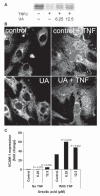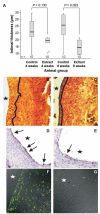Inhibition of cell surface expression of endothelial adhesion molecules by ursolic acid prevents intimal hyperplasia of venous bypass grafts in rats
- PMID: 22551965
- PMCID: PMC3523388
- DOI: 10.1093/ejcts/ezs128
Inhibition of cell surface expression of endothelial adhesion molecules by ursolic acid prevents intimal hyperplasia of venous bypass grafts in rats
Abstract
Objectives: Despite rapid progress in surgical techniques, there is still a significant lack of surgery-supportive pharmacological treatments. The aim of this study was to test the hypothesis that ursolic acid (UA) may prevent intimal hyperplasia of venous bypass grafts.
Methods: The hypothesis was tested by means of primary cell isolation and culture followed by real-time polymerase chain reaction, western blotting, fluorescence microscopy and fluorescence-activated cell sorting analyses, as well as an in vivo rat model for intimal hyperplasia of venous bypass grafts and immunohistochemistry and histochemistry.
Results: The local application of UA significantly inhibited intimal hyperplasia in vivo (intimal thickness control: 25 µm, UA group: 18 µM-8 weeks after surgery). The UA treatment of grafts significantly resulted in reduced endothelial vascular cell adhesion molecule-1 (VCAM-1) expression, reduced infiltration of the grafts vessel wall by CD45-positive cells and increased smooth muscle cell (SMC) death. In in vitro condition, it could be shown that UA inhibits VCAM-1 expression downstream of NFκB and is likely to interfere with VCAM-1 protein synthesis in endothelial cells. Quantification of cell death in vascular smooth muscle cells treated with UA indicated that UA is a potent inducer of SMC apoptosis.
Conclusions: Our results suggest that UA-mediated inhibition of endothelial VCAM-1 expression reduces the infiltration of venous bypass grafts by CD45-positive cells and inhibits intimal hyperplasia. Apoptosis induction in SMCs may be another method in which UA reduces intimal thickening. UA may constitute a surgery-supportive pharmacon that reduces intimal hyperplasia of vein grafts.
Figures




Similar articles
-
Prevention of focal intimal hyperplasia in rat vein grafts by using a tissue engineering approach.Atherosclerosis. 1998 Oct;140(2):365-77. doi: 10.1016/s0021-9150(98)00143-9. Atherosclerosis. 1998. PMID: 9862280
-
Rapamycin-loaded nanoparticles for inhibition of neointimal hyperplasia in experimental vein grafts.Ann Vasc Surg. 2011 May;25(4):538-46. doi: 10.1016/j.avsg.2011.01.003. Ann Vasc Surg. 2011. PMID: 21549923
-
[Local shRNA modulation of phosphatidylinositol 3-kinase signaling pathway reduces intimal hyperplasia in vein grafts: experiment with rats].Zhonghua Yi Xue Za Zhi. 2007 Jun 26;87(24):1713-6. Zhonghua Yi Xue Za Zhi. 2007. PMID: 17825157 Chinese.
-
Pathophysiology of vein graft failure: a review.Eur J Vasc Endovasc Surg. 1995 Jan;9(1):7-18. doi: 10.1016/s1078-5884(05)80218-7. Eur J Vasc Endovasc Surg. 1995. PMID: 7664016 Review.
-
Role of the renin-angiotensin system in the pathogenesis of intimal hyperplasia: therapeutic potential for prevention of vein graft failure?Ann Vasc Surg. 2012 Nov;26(8):1130-44. doi: 10.1016/j.avsg.2011.12.001. Epub 2012 Mar 22. Ann Vasc Surg. 2012. PMID: 22445245 Free PMC article. Review.
Cited by
-
Ursolic acid enhances the effect of exercise training on vascular aging by reducing oxidative stress in aged type 2 diabetic rats.Food Sci Nutr. 2022 Oct 17;11(2):696-708. doi: 10.1002/fsn3.3105. eCollection 2023 Feb. Food Sci Nutr. 2022. PMID: 36789048 Free PMC article.
-
Beneficial Effects of Ursolic Acid and Its Derivatives-Focus on Potential Biochemical Mechanisms in Cardiovascular Conditions.Nutrients. 2021 Oct 30;13(11):3900. doi: 10.3390/nu13113900. Nutrients. 2021. PMID: 34836155 Free PMC article. Review.
-
A new CHO (Chinese hamster ovary)-derived cell line expressing anti-TNFα monoclonal antibody with biosimilar potential.Immunol Res. 2018 Jun;66(3):392-405. doi: 10.1007/s12026-018-8997-4. Immunol Res. 2018. PMID: 29855993
-
Dietary 23-hydroxy ursolic acid protects against atherosclerosis and obesity by preventing dyslipidemia-induced monocyte priming and dysfunction.Atherosclerosis. 2018 Aug;275:333-341. doi: 10.1016/j.atherosclerosis.2018.06.882. Epub 2018 Jun 27. Atherosclerosis. 2018. PMID: 30015296 Free PMC article.
References
-
- Crook MF, Newby AC, Southgate KM. Expression of intercellular adhesion molecules in human saphenous veins: effects of inflammatory cytokines and neointima formation in culture. Atherosclerosis. 2000;150:33–41. - PubMed
-
- Hansson GK. Inflammatory mechanisms in atherosclerosis. J Thromb Haemost. 2009;7:328–31. - PubMed
-
- Lau GT, Ridley LJ, Bannon PG, Wong LA, Trieu J, Brieger DB, et al. Lumen loss in the first year in saphenous vein grafts is predominantly a result of negative remodeling of the whole vessel rather than a result of changes in wall thickness. Circulation. 2006;114:1435–140. - PubMed
-
- Blankenberg S, Barbaux S, Tiret L. Adhesion molecules and atherosclerosis. Atherosclerosis. 2003;170:191–203. - PubMed
Publication types
MeSH terms
Substances
Grants and funding
LinkOut - more resources
Full Text Sources
Research Materials
Miscellaneous

